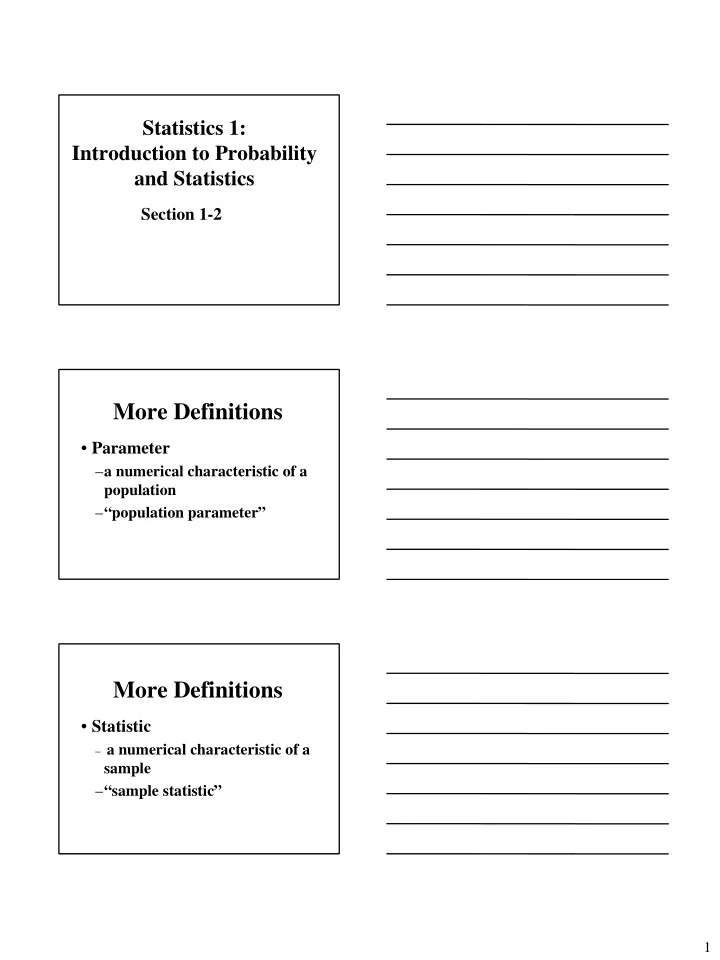

Statistics 1: Introduction to Probability and Statistics Section 1-2 More Definitions • Parameter – a numerical characteristic of a population – “population parameter” More Definitions • Statistic – a numerical characteristic of a sample – “sample statistic” 1
Examples of “numerical characteristics” 1. Average or Mean 2. Biggest (maximum) value 3. Smallest (minimum) value 4. Range : maximum - minimum A Statistic is: • A function of data • Function : y = f(x) – the value of “x” determines the value of “y” • The average is a function of a set of “x” values; the average of 4, 6, and 8 = 6. Start with the sample or the population? • Sometimes we have a sample and we need to consider the population or populations that the sample represents 2
Start with the sample or the population? • A sample is likely to be “representative” (it looks like the population) if it is collected in a well-planned and well-executed manner The Nature of Data Definitions • Quantitative vs. Qualitative • Discrete vs. Continuous • Four “levels” of measurement 3
Definitions • Quantitative vs. Qualitative • Quantitative Data are numbers that represent counts or measurements • Qualitative Data may represent categories based on a non-numerical characteristic • Sometimes called categorical or attribute data 4
Definitions • Discrete vs. Continuous Definitions • Discrete • The set of possible values can be counted (possibly infinite) • Main example: “Counts” Definitions • Continuous • The possible values cannot be counted. Even in a small range, the possibilities are infinite. • Main example: “Measurements” 5
Definitions • Four “levels” of measurement – Nominal – Ordinal – Interval – Ratio Definitions • Four “levels” of measurement – Nominal • “name” • not quantitative • cannot compare magnitudes Definitions • Four “levels” of measurement – Nominal • New York, San Francisco, Sacramento, Lodi • Other attributes of these cities can be compared as quantities, but not the names 6
Definitions • Four “levels” of measurement – Ordinal • “names” or categories • not quantitative • can be compared in magnitude as “less than” or “greater than” only Definitions • Four “levels” of measurement – Ordinal • small, medium, large • can be put in order according to magnitude, but other comparisons cannot be done Definition s • Four “levels” of measurement – Interval • values represent magnitude explicitly • can be put in order, and • intervals can be compared, but • ratios cannot be compared 7
Definitions • Four “levels” of measurement – Interval • Temperatures • 0 o C, 10 o C, 20 o C • can be put in order • interval from 0 to 10 is the same as 10 to 20 Definitions • Four “levels” of measurement – Interval • Temperatures • 0 o C, 10 o C, 20 o C • 20 is not “twice as hot” as 10 Definitions • Four “levels” of measurement – Interval • These temperatures are the same • 0 o C, 10 o C, 20 o C; 20 ÷ 10 = 2 • 32 o F, 50 o F, 68 o F; 68 ÷ 50 = 1.36 • 273 o K, 283 o K, 293 o K 293 ÷ 283 = 1.04 8
Definitions • Four “levels” of measurement – Ratio • Values represent magnitude explicitly • Can be put in order • Intervals can be compared • Ratios can be compared Definitions • Four “levels” of measurement – Ratio • Natural not arbitrary “zero” • Speed, weight, elapsed time, voltage, distance • 60 miles per hour is twice as fast as 30 miles per hour 9
Recommend
More recommend